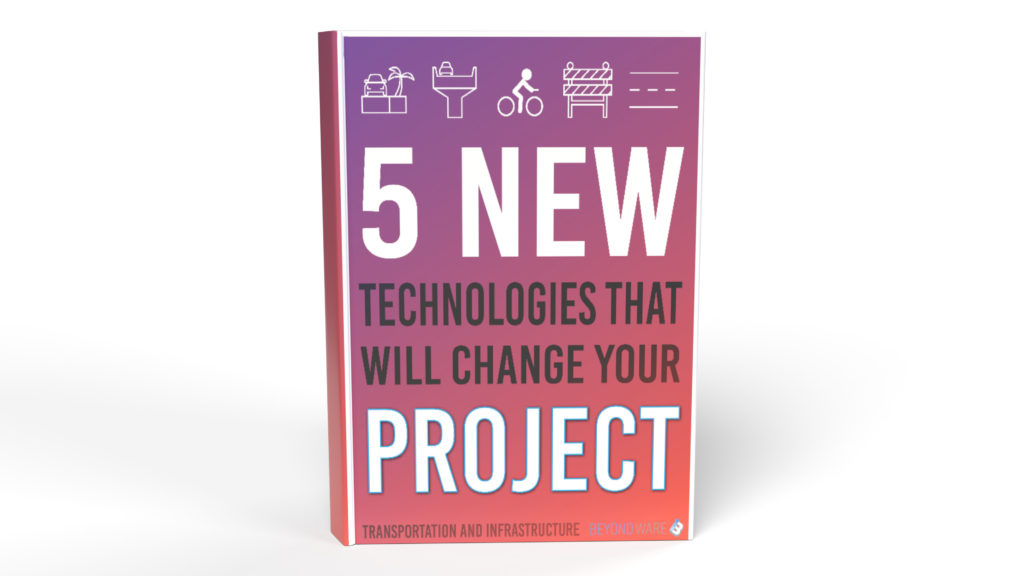Technology advances in the past decade have flooded every industry and market, including our own transportation and infrastructure. These advances are more than mere virtue signals of innovation, but, with currently available applications, are already bringing significant cost savings and efficiencies to projects throughout the world.
There are 5 technologies overviewed in this report that are available today and represent the most available and efficient applications for transportation and infrastructure projects. Utilizing these technologies can help your project stay under budget and on schedule, and ultimately change your project TODAY.
1 | VR/AR
While virtual reality (VR) has technically been around for decades, advancements in the past 10 years have taken this technology from science fiction to nearly commonplace. The Oculus Rift ushered in an entirely new experience, and subsequent VR headsets have continued to improve upon this revolutionary product. Companies like Sony, Vive and Meta have invested billions in innovating and marketing this technology to push VR from the fringe into mainstream. New headsets like the Oculus Quest are portable, untethered AND nearly photo-realistic.
Augmented reality (AR) is the related technology that allows users to see the real-world with virtual elements overlain on top of reality. Common applications include the ‘first down line’ and other digital elements in sports and games like Pokemon GO introduced the world to AR using smartphones. AR headsets and head-mounted displays take real-world augmentation to the next level by making the entire world immersive. Current AR application is in the form of bulky VR-like headsets (like the Hololens) but emerging products promise AR in the form of light-weight glasses or (someday) even contact lenses.
In infrastructure, virtual and augmented realities are already in use. Public outreach efforts can utilize a pre-recorded virtual VR experience that allows stakeholders and members of the public to ‘fly’ through or over a proposed project in a helicoptor. Real-time virtual reality offers the ability to walk a proposed project and even change options or alternatives in real-time. Augmented reality can be harnessed by using BIM models or 3D visualization with users on-site by overlaying the proposed elements on the real-world.
2 | Drones
Drones or ‘Unmanned Aerial Vehicles’ (UAVs) have become so effective and affordable in recent years that many projects use them not for one, but for multiple purposes. And not only has the technology improved exponentially, but regulations have made it possible for hobbyists to practice and non-pilots to gain commercial licenses. The bar has been lowered so low that many contractors and engineering firms have their own drones and operators, as opposed to outsourcing these services in years past.
Drones can be currently utilized for aerial survey (photo and 3D), progress photos, quantity calculations, security, project management and more. While many of these abilities are possible with a low-cost drone that only has a camera, higher-priced options allow for actual LiDAR and other scanning abilities. In fact, drones have become so good in recent years that surveying tasks are now being done by drone operators with accuracy in less than an inch to rival traditional survey technologies. The same can be said for project flight teams that are now either using drones or being replaced by them outright.
Why own or hire an airplane and crew to take an aerial survey of a project when it can be done in a fraction of the cost with a drone and single operator?
In coming years, drone technology will continue to improve and these products will get lighter, more affordable and more capable, and hopefully the regulations will follow suit. Look for drones to be an integral of every project- during every phase of development- in the coming years.
3 | Photogrammetry
Photogrammetry involves the processing of images into a 3D surface. Advanced algorithms find similar elements in overlapping images of any object to develop accurate surfaces and textures.
In years past, generating accurate 3D surfaces required expensive scanning equipment like LiDAR that would bounce millions of lasers off surfaces to collect points and, ultimately, generate 3D data. Photogrammetry has emerged in recent years as a much more affordable and accessible option for surface generation, as it requires nothing more than a decent image camera. In fact, the cameras on most smartphones are more than capable enough for photogrammetry, and many apps exist that allow users to turn household objects into 3D surfaces by just taking a number of pictures with their phones.
In infrastructure, photogrammetry is becoming mainstream as many of the top AEC software companies are offering products that make photogrammetry generation easier than ever. Using drones, contractors or engineers can generate 3D terrain surfaces that can be used for quantity take-offs, design surfaces or 3D visualization. These surfaces can be geolocated and edited with accuracy in inches or less. Multiple surfaces can be generated of a project over time to accurately measure changes as construction progresses.
While photogrammetry has improved substantially over the past decade, it can still be costly. Competition and open-source software should drive the cost and accessibility of this technology even further.
4 | Internet of Things
With high-speed internet blanketing the world in the past 20 years, product manufacturers have raced to make everything from toothbrushes to power meters connected to the web. Both the software and hardware have become so affordable that there are few products that aren’t available in an internet connected version. This is often referred to as the ‘Internet of Things’ or IOT.
In transportation and infrastructure, connected devices aren’t exactly new. Traffic signals and counters have been connected to central hubs for many years, but this doesn’t mean this industry doesn’t stand to benefit from recent innovations. Current and upcoming applications include preventative maintenance, asset management, construction management streamlining (tracking equipment, supplies and personnel…), safety as well as overall construction and maintenance efficiencies.
With the ability to embed internet-connected sensors into infrastructure elements such as safety devices, bridge structures, road surfaces, cameras and more, projects are and will continue to become living systems that can be tracked and managed in hours and days instead of months or years.
Some IOT technologies don’t even require new sensors. Existing data coming from older sensors, smartphones and even the latest vehicles can be aggregated and used in conjunction with new hardware to manage entire systems.
5 | 3D Visualization
While 3D visualization has been around for many years in architecture, it is still an emerging technology in transportation and infrastructure, especially real-time visualization. Viz studios and engineering firms are now utilizing the latest gaming engines and graphics card advances to leverage real-time 3D visualization on even the biggest infrastructure projects.
While transportation and infrastructure still lags architecture in visualization, innovation in software is making photorealistic 3D visualization more accessible and affordable than ever for our industry. While architecture has had specialized visualization engines like Lumion and Twinmotion for many years, only recently have similar tools been available for civil projects.
To be fair, 3D visualization is much more complex for a 5 mile long freeway reconstruction than it is for a high-rise building. Elements like realistic traffic movements and terrain cuts and fills make our projects many times more complicated than most architecture projects.
Still, recent advances have made transportation and infrastructure visualization possible, not just for viz studios, but for the engineers and CAD operators doing the actual design.
Continue below to the Conclusion for information on how you can try this new software for yourself at no cost.
Conclusion
I’ve spent more than a decade focused on 3D visualization in transportation and infrastructure. This started in college at UNLV and continued at the Nevada Department of Transportation and for private engineering consulting firms and culminated in the formation of a 3D visualization studio, Civil FX, in 2014. While starting, growing and ultimately selling Civil FX in 2020, I realized that while Lumion, Twinmotion and similar products had changed visualization and made it more accessible in architecture, no
similar products existed for our industry.
For several years now, I’ve been intensely focused on making the better 3D visualization tools that we didn’t have when I was running Civil FX. Beyond Typicals is easy to use for your transportation projects. This is the all-new, drag-and-drop 3D typical section creator that can be used to communicate projects and construction in minutes instead of hours, days or even
weeks.
It is my hope that you will find these tools as useful as we’ve hoped to create them, and you will start a free 30-day trial today.
-Sam Lytle, PE
Beyond CAD Inc

